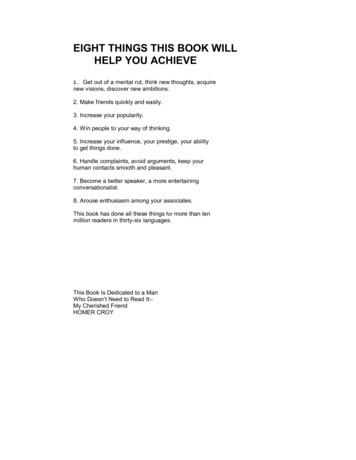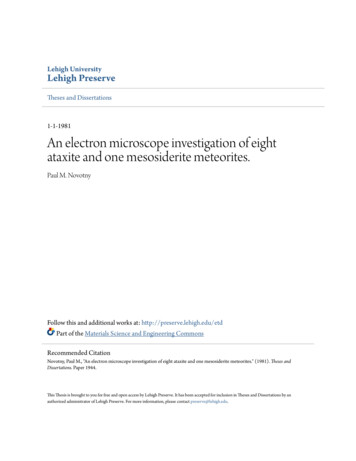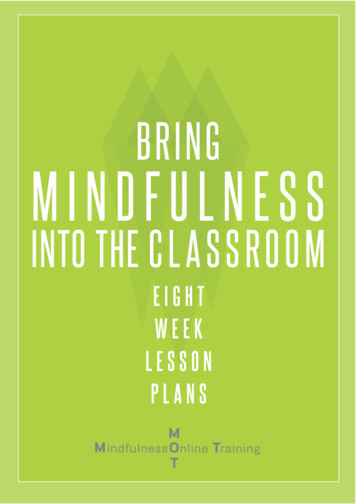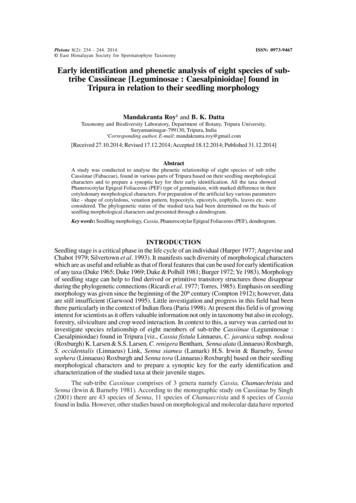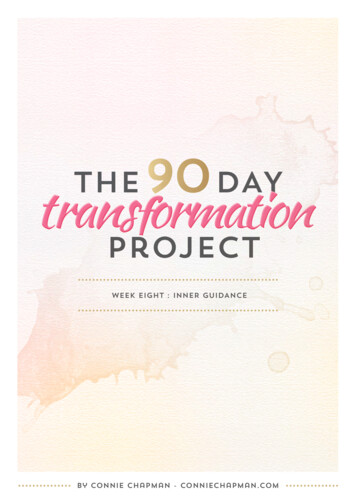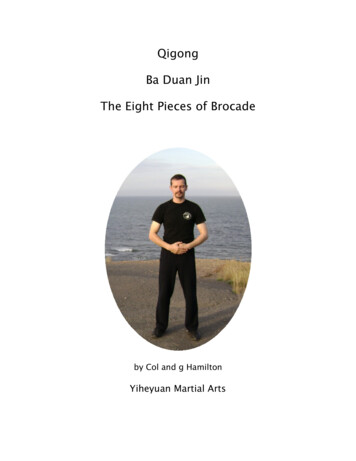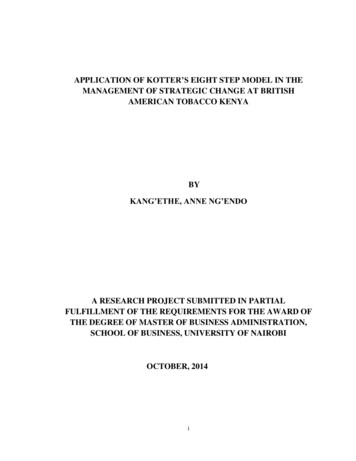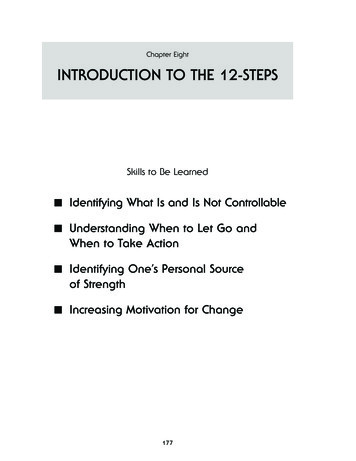
Transcription
Chapter EightINTRODUCTION TO THE 12-STEPSSkills to Be Learned Identifying What Is and Is Not Controllable Understanding When to Let Go andWhen to Take Action Identifying One’s Personal Sourceof Strength Increasing Motivation for Change177
Introduction to the 12-StepsIn this chapter we are going to introduce you to the 12-step philosophy ofAA and NA (Alcoholics and Narcotics Anonymous). The 12-steps teach youthat recovery not only involves being abstinent from drugs, it also involveschanging your entire way of living—your attitudes, beliefs, thoughts, feelings, and behavior.You’ve probably noticed that HHRP frequently refers to the serenity prayer:God grant me the serenityto accept the things I cannot change,the courage to change the things I can,and the wisdom to know the difference.Clearly, as suggested by the prayer, the first order of business is to identifythose things in your life that can’t be changed so that you can “turn themover” or “let them go.” By doing this you become empowered to identifywhat problems require your attention and you gain courage to carry outwhatever actions are required to make the necessary changes in your life.Finding the right balance between “letting go” and “taking action” is a signof wisdom. The 12-steps have helped many people find this balance, notonly in the addictions but also in coping with chronic illness. This chapterwill briefly introduce you to the 12-steps. This introduction to the steps doesnot take the traditional approach; rather, it provides a broad interpretationof the steps so that you can find what is meaningful to you. People spendtheir entire lives “working the steps;” therefore, this chapter is not meant tobe comprehensive, and, in fact, it will cover some very important issues onlysuperficially. You are strongly encouraged to attend 12-step groups in yourcommunity where you can get in-depth information and guidance about the12-step program.178
Introduction to the 12-StepsThe meaning of the word “powerless” is often misinterpreted in the contextof this step. How do you interpret the word “powerless” in this step?Consider the following: This step does not mean you are powerless to make changes in your life. As the serenity prayers suggests, your first priority is acceptance ofthings you cannot change. You have to begin with acknowledging thatyou have a problem. One thing you cannot change is the effect of drug use on your life; thechemical effect of the drug has enslaved you and you are powerless tochange the drug’s negative effect. Your life has become unmanageable because the drug is in control. Once you admit your powerlessness, you empower yourself to begin totake control over those things in your life you can change—such as thedecision not to use drugs. Therefore, this first step actually empowers you to begin your journey of recovery. You find serenity in acceptance of the things youcannot change, such as the negative effect of drug use in your life,and then can then begin to gain the courage to change the thingsyou can.179
Introduction to the 12-StepsNo one can define your “higher power” for you. What does “a power greaterthan ourselves” mean to you? Consider the following: For some people, their “higher power” is the God of their religious beliefsand practices. QUIZ ITEM For others, it may be nature, love, the life force, chi, or energy. QUIZ ITEM It could even be your strong desire for “sobriety” or “a healthy lifestyle”—that part of your being that is your source of strength to achieve sobrietyand good health. QUIZ ITEM You don’t need to be religious in the conventional sense to work the steps.To summarize Steps 1 and 2—In Step 1 you accept that the effect of drugs onyour life is beyond your control and that you have reached the point at whichyour life has become unmanageable. Then Step 2 tells you that there is hopefor a better life if you truly believe that there is a source of strength availableto you that can enable you to live a drug-free life.180
Introduction to the 12-StepsIf “God” is your higher power—your source of strength, however, you definethis—what does it mean to decide to turn your will and life over to God?Consider the following: It does not mean that:– you must be religious in order to work the steps.– you surrender to another’s will. It does mean that you have now made the decision to give up your old lifeof addiction and devote yourself to a new drug-free life based upon whatever your “higher power” represents (for example: serenity, spirituality,balance). You surrender to (you become) your source of strength. In this step you actually make your decision. It is the connection betweenyour strong belief that a drug-free life is possible for you (Step 2) and taking action in Step 4.181
Introduction to the 12-StepsWhat is a searching and fearless moral inventory? Consider the following: A fearless moral inventory is an honest self-examination to identify yourstrengths and weaknesses. It does not mean focus only on your weaknesses or focus on how othersperceive you. It does mean:– get to know yourself—your “addict” self, your “ideal self,” your“spiritual self,” your many “selves.”– understand the connection between your different senses ofself and your addiction.So, in Step 1 you accept that addiction causes powerlessness, in Step 2 youbelieve that a new life is possible, in Step 3 you decide to devote yourself tothis new drug-free life, and now in Step 4 you begin to take action by conducting a thorough self-examination to determine what you may need tochange in order to embark on this this new drug-free life. This gets youready for Step 5.What does it mean to admit our wrongs? Consider the following: In this step, you begin to bring other people into your journey of recoveryand give voice to that private self-examination you conducted in Step 4. It does not mean:– You should now admit your wrong-doings to all those you wronged.Not yet anyway!182
Introduction to the 12-Steps– You should wallow in shame and guilt. This can lead quickly backto addiction.– You should attempt to justify your actions to this other person. It does mean:– You should identify the specific harms that your life of addiction hascaused to:- You (don’t forget the ways in which you have harmed yourself.- Other people.- Your higher power (have you compromised your beliefs, values,integrity, and wasted your talents?).– Having the courage to reveal yourself with all your failings to another person—this requires trust which is essential for a drug-freelifestyle.What is meant by defects of character? Consider the following: Having identified what needs to be changed in previous steps, this stepinvolves getting ready to make fundamental changes in your way of life. Defects of character refers to your old way of living and thinking—your“addict” self. You are now ready for God, your higher power (however you define yoursource of strength) to eliminate your “addict” self and to permit your“ideal” self to emerge.So working this step means that you are ready to let go of your old183
Introduction to the 12-Steps“addict” life. This step represents the mental process that is necessarybefore you can take action in the next step.How does this step relate to Step 6? Consider the following: Step 7 is the action part of Step 6. This is when you say goodbye to your old life and invite your new drugfree life to begin. It does not mean that your drug-free lifestyle is in someone else’s hands. It does mean:– Learning to say no to drugs, going to new places, meeting newpeople, changing your attitudes, setting and resetting goals.– Being patient—change takes time.– Working hard—change takes effort.– Asking for help when you need it.So, Step 7 is the self-improvement step. Here you make changes to your“self”—you change the attitudes, beliefs, and behaviors that have kept youfrom achieving physical, emotional, and spiritual health.184
Introduction to the 12-StepsIs this step an action step or a mental process? Consider the following: Although this step requires action in that you generate a list of those youhave harmed, it is the essential mental process required for action in Step 9. Before you can attempt to make amends, you need to be willing to do so,and you need to identify each person you have harmed. This requires:– Being honest with yourself and others about the harm you havecaused.– Having empathy for the feelings of another.– Having regret for the harm you caused.– Making the decision to disclose your feelings to someone who maynot think highly of you. You must not proceed to the next step until you have done this. If youproceed to action without deep personal conviction, the result is insincerity; insincerity is part of your old “addict” life, and has no place in yourrecovery. Place yourself on your list of people you have harmed and be willing toforgive yourself.M Having given up your “addict” ways in the previous step, in this step youmake the decision to demonstrate your sincere regret to others about yourprevious “addict” behavior.This step is the essential mental process required for taking action in thenext step.185
Introduction to the 12-StepsReviewLet’s review what we’ve covered so far. We’ve discussed the first 8 steps inthe 12-step program of recovery. Although some of the steps seem similarupon first reading, with careful analysis you saw that each step moves youto the next step. For example, the necessary mental process always comesbefore the action step. You also saw that the journey of recovery includesother people in your life and attempting to make amends for your previouslifestyle. Let’s review the first eight steps briefly.Step 1.You accept that your unhealthy lifestyle has become unmanageable—this is a mental process.Step 2.You strengthen your belief in a healing power that can changeyour life—this is a mental process.Step 3.You make the decision to give up your old lifestyle—this is a mental process.Step 4.You identify what personal changes you need to make in order tolive a healthier lifestyle—this is an action step that can’t be takenin the absence of the previous mental processes.Step 5.You then disclose to at least one other person what you need tochange about yourself—action step.Step 6.You experience readiness to change your life—mental process.Step 7.You begin to make personal changes—action step.Step 8.You made the decision to make amends to those you harmed—thisis the mental process necessary for taking action and for involvingothers in Step 9.186
Introduction to the 12-StepsWhat does it mean to make direct amends? Consider the following: This is an action step. Having made the decision to make amends, younow go into action and take responsibility for the harm you caused others. The point of this step is to acknowledge past harm (not necessarily fix it),and then let it go. Making amends may include compensation of some kind, and/or a sincereapology, depending upon the situation. This step does not mean:– you will be forgiven by those you harmed. Being sorry does notensure forgiveness. Remember one of the things you cannot controlis someone else’s response. Go into this step with no expectationsabout the other’s response. Even if the other person does not acceptyour apology, you know you are sincerely sorry, and you can now letit go and move forward with your life.– that people who have harmed you will attempt to make amends toyou. Remember you can’t control someone else’s behavior. If othershave harmed you, you need to make amends to yourself. Thismeans being willing to honor yourself and remove yourself fromrelationships than cause you harm.So, in Steps 8 and 9, you take on the attributes that are essential for yournew healthy lifestyle—being honest, taking responsibility, having compassion and empathy, and doing whatever you can to prevent future harm.Although you cannot reverse the harm you caused, you can reduce futureharm.187
Introduction to the 12-StepsHow does this step differ from previous steps? Consider the following: This step is the maintenance agreement you make with yourself. Initiating abstinence from drugs is extremely important, but being able tomaintain a drug-free lifestyle is equally important. This takes effort. It is easy to fall back into old patterns, so you need to be vigilant. You agree to monitor your moods, feelings, thoughts, and actions. (Thiscan be done daily in quiet time, or in a diary, or through conversationswith a friend). You agree to acknowledge to yourself and others when you are wrong(when you have inadvertently slipped back into old “addict” ways). In this step, identify and acknowledge your ongoing strengths and successes as well as continuing to address your weaknesses head on.What is “God's will for you?” Consider the following: In Step 3, you made the decision to give up your old life of addiction anddevote yourself to a new drug-free life and to your “higher power” (forexample: serenity, enlightenment, balance). This is “God’s will for you.” Recovery from addiction is not a destination, it is a process. After yougive up your old life and begin your new life, and ensure that you canmaintain it, your life can continue to unfold in a positive way. Thisprocess is ongoing. Your life unfolds in a positive way, through prayer and/or meditation, selfreflection, and reaching out for help.188
Introduction to the 12-Steps Step 11 is about:– The growth of serenity, courage, and wisdom.– Acknowledging that you don’t always have all the answers.– Acknowledging that you need help and support in order to continueto grow.How can it help your recovery to help others? Consider the following: When you share with others:– You strengthen your own beliefs.– You make the steps real, more concrete.– You make the steps more available to you in times of high risk.– You receive a gift of inner peace by sharing what you know. This step reminds you to:– Share solutions, not problems. Rather than engage other drug usersin what we call drug-a-logs (stories about drug use), communicatewith others about what helps you to stay abstinent.– Remain humble—remember where you came from.– Practice what you preach (walk the walk, don’t just talk the talk).In previous steps you reached out for guidance. You changed your life. Youdemonstrated a desire to allow your life to unfold to its highest potential.Now, in reaching out to provide support to others, you begin to experiencethe joy of living your life to its highest potential.189
Introduction to the 12-StepsRecovery from addiction and living a healthy lifestyle are not destinations.Each is a process – a journey. The journey requires honest self-reflectionand reaching out to others. The 12 step program can guide you on this journey. It is important to remember that the steps have different meanings fordifferent people. Your journey may not be the same as your neighbor’s journey. This is what makes the steps so powerful. In this chapter, we have deemphasized the religious interpretation of the steps in order to demonstratehow the steps can be interpreted in different ways. We want to emphasizethat it is not important how someone else interprets the steps. It is onlyimportant how you interpret them. Find what you need in them.Everything you need for your journey is right there if you are willing to look,and if you are truly open to discovering your highest potential. You arestrongly encouraged you to attend a 12-step meeting in your community.Practice Exercise: Learning the StepsInstructions:1. At the end of this chapter is a Worksheet entitled “12-Step GameBlank Worksheet” on which are listed the 12 steps. The steps are notin the correct order on this worksheet.2. Put the steps in the correct order by writing the number in the boxprovided. You can check your answers by referring back to the text inthis chapter.3. Plan to attend a 12-step meeting in your community during the coming week (enter the date, time, and location in the schedules section ofyour Workbook).190
Introduction to the 12-StepsQuiz1. In the Serenity Prayer you ask for:a.b.c.d.serenity to accept the things you cannot changecourage to change the things you canwisdom to know the differenceall of the above2. Step 1 of the Twelve Steps says that you are powerless over youraddiction; this means:a.b.c.d.you cannot change your lifethe drug is in control; you cannot change the effect of drugsyou should leave your recovery in your sponsor’s handsyou cannot change your dealer’s behavior3. You need to be religious to benefit from the 12-Steps:a. Trueb. False4. A person’s “higher power” is:a.b.c.d.Godnature, loving energy, life forcean inner source of strength and healingany of the above5. Steps 8 and 9 refer to making amends to those you have harmed.Making amends includes:a.b.c.d.forgiving yourself for any pain you caused yourself or othersbeing honest with yourself and others about the harm you causedacknowledging past harm, not necessarily fixing it, and then letting it goall of the abovePractice Exercise:Stress Management/RelaxationWe recommend that you conclude each chapter by doing a 10-minute relaxation exercise. Use this time to practice meditation, deep breathing, or visualization. Dim the lights, get comfortable in your chair, uncross your legs, andsit quietly with your eyes closed. Remember that learning to relax is a skillthat takes practice, so if you feel restless at first, just remind yourself thatthis is a 10 minute gift of quiet time that you give to yourself. With practice,you can use meditation and relaxation in many areas of your life includinghelping you to “work the steps.” So use this time now to practice becomingcentered, relaxed, and focused on whatever step you have reached so far.191
Introduction to the 12-Steps12-Step Game Blank Worksheet192
Introduction to the 12-Steps12 Steps in a Journey of Recovery“Having had a spiritual awakening as the result ofthese steps, we tried to carry this message to others,and to practice these principles in all our affairs.”Share by doing.12“Sought through prayer and meditation to improve our conscious contact with God as we understood him, praying only forknowledge of His will for us and the power to carry that out.”Continue to grow to highest potential.11“Continued to take a personal inventory and when we were wrongpromptly admitted it.”Maintain your new healthier life.10“Made direct amends to such people whenever possible, except when to do sowould injure them or others.”Demonstrate your regret.9“Made a list of all persons we had harmed, and became willing to makeamends to them all.”Identify harm you’ve caused.8“We humbly asked Him to remove our shortcomings.”Begin to make the personal changes necessary to heal your life.7“We were entirely ready to have God remove all these defects of character.”Be ready to change – Choose to let go of your old lifestyle.“We admitted to God, to ourselves, and to another human being the exact nature ofour wrongs.”Tell someone else what you need to change about yourself.65“We made a searching and fearless moral inventory of ourselves.”4Identify what you need to change about yourself.“We made a decision to turn our will and our lives over to the care of God as we understood Him.”3Make the decision to heal your life.“We came to believe that a power greater than ourselves could restore us to sanity.”Hope for the future – Believe that a healing power exists.“We admitted that we were powerless over our addiction, that our lives had become unmanageable.”Accept what cannot be changed – Effect of drugs and current HIV status.19321
Introduction to the 12-StepsNotes194
Introduction to the 12-StepsNotes195
Introduction to the 12-StepsNotes196
Introduction to the 12-Steps I n this chapter we are going to introduce you to the 12-step philosophy of AA and NA (Alcoholics and Narcotics Anonymous). The 12-steps teach you that recovery not only involves being abstinent from drugs, it also involves changing your entire way of living—yo
